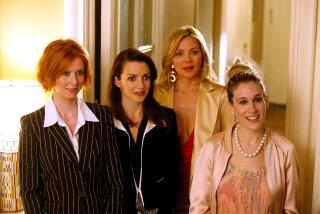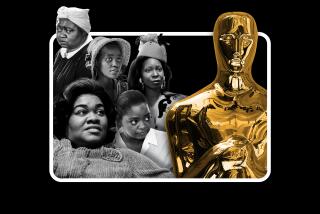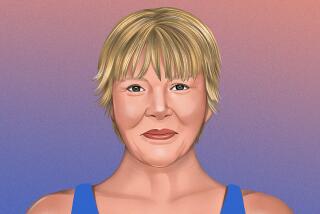Kate Winslet: Female powerhouse
Kate Winslet doesn’t mind that she looks older these days. “Look here,” says the 35-year-old actress, pointing high up on her forehead. Her still slightly damp hair is slicked back into a ponytail, and when she moves her eyebrows upward, her skin crinkles up. “Hello!” she says, laughing. “I have a few more wrinkles than I used to.”
Sitting in a French cafe in Manhattan, smartly attired in a camel-colored blazer, a black scarf and makeup that’s designed to look like she’s not wearing any, Winslet says she was proud to see new creases on her face during a recent screening of “Mildred Pierce,” a five-part miniseries that finds the actress in the title role as an upwardly mobile housewife during the 1930s. (Parts 1 and 2 air Sunday night on HBO.) “I watched myself on-screen, and you could really see my crow’s-feet,” she admits, a bit gleefully. “I was like, ‘My forehead moves! Good girl!’”
Being a normal thirtysomething actress with fully functioning human parts is a big part of Winslet’s appeal and a major reason why so many women feel they can relate to her. She’s long dismissed Botox. Her nude scenes once made Oprah Winfrey gush, “God bless your natural breasts!” And even before “Mildred Pierce,” she’d brought an inner fire to supposedly ordinary housewives, such as the ones in 2006’s “Little Children” and 2008’s “Revolutionary Road.”
Winslet may love the lines on her forehead, but she’s earned them over a rough couple of years. First, there were those rumors of on-set tension between her and her husband, Sam Mendes, who directed her in “Revolutionary Road,” a film that happened to be about a derailing marriage. Then there was the demanding Academy Awards race that found her advocating for two films at once — “Revolutionary Road” and “The Reader” — and winning a lead actress statue for the one her husband didn’t direct. In a teary acceptance speech, she thanked Mendes, insisting “hand on heart” that she loved working with him, but by 2010, their seven-year marriage had ended “by mutual agreement.”
“Mildred Pierce” is her first project since that breakup — and certain scenes eerily mirror their split. Based on James M. Cain’s 1941 novel of the same name, the miniseries follows a Glendale matriarch who’s struggling to maintain her family’s social class during the Depression, working to create a better life for her self-absorbed daughter Veda (Evan Rachel Wood). The story begins when Mildred decides to leave her husband, Bert, and care for their two daughters by herself at a time when women didn’t get divorces, much less jobs.
Winslet, who has two children of her own, grew to dread the scenes where Bert and Mildred fought about their separation. The subject still felt too raw, and the ambitious 17-week shoot in New York, which required her to appear in every scene, was grueling. “It was tough,” she says, modifying the word “tough” with a more emphatic term that cannot be used here. “There were days when I’d be in the car on the way to work, and I’d almost feel comatose. I’d actually say out loud, ‘I can’t. I can’t. I can’t.’”
At times, the coincidences seemed almost cruel. On the same day that Winslet filmed an emotional scene where Mildred and Bert finally agree to get a divorce, her own divorce papers came through. “It was one of those moments where I wasn’t even aware that I was using those things from my real life in my performance,” she says, staring down into her mug of coffee. “It was just right there in me.”
Winslet found herself leaning on director Todd Haynes, who she says was a source of strength. “He’s interested in these emotional female powerhouses who have a rich story to tell,” she says. “Thank God that us girls have Todd.” Like Winslet’s films, Haynes’ projects tend to focus on women who are trapped in suffocating domestic situations, whether in self-help-obsessed Southern California (“Safe”) or the 1950s suburbs (“Far From Heaven”). In “Mildred Pierce,” he often makes those trappings literal by framing Winslet through a kitchen window or a half-closed door, as if challenging her to break out of her house.
Though the Berkshire, England-born Winslet might not seem the ideal choice for such an American role, Haynes saw parallels between the actress and Mildred early on. He’d seen Joan Crawford in the original 1945 version in the 1980s, when he was studying art and semiotics at Brown University, where the melodrama was often viewed in feminist film theory classes as a radical attempt to blend the conventions of so-called women’s pictures with the more masculine escapism of film noir. (With Crawford’s oversized shoulder pads and affinity for handguns, Mildred’s more of a man then most of the men in her life.) But it wasn’t until Jon Raymond, Haynes’ cowriter on the project, gave him a copy of the book in 2008 that he began to picture Winslet in the role.
“Mildred was an attractive dirty blond-haired young mother of two girls, and they made a real point of the fact that she was 17 when she had Veda,” says Haynes. (Winslet married young and had her daughter, Mia, with first husband Jim Threapleton at age 25.) “I couldn’t shake Kate from my mind.”
But it was Winslet’s naturalistic acting style that cemented her as Mildred. Aiming to distinguish the miniseries from the highly stylized classic, Haynes wanted to blend the language and storytelling of melodrama with what he calls the “dressed-down” style of American filmmaking during the 1970s. “Those films like ‘Chinatown’ or ‘The Godfather,’ the actors that didn’t look like perfect movie stars, and they weren’t tailored that way. I wanted to bring that to Mildred, and it all started with Kate.”
One of the miniseries’ major themes is a classic one for melodrama: Happy endings are not always happy, and no one can ever really have it all. For Haynes, the 1930s was defined by the middle-class aspirations set into motion after that decade of great American prosperity, the 1920s. Maternal desire started to get tangled up in dreams of moving up the ladder. “Having your child have access to things you didn’t, that’s the American dream,” he says. “But in excess, it becomes dangerous.”
Working on early drafts of the script in 2008, when the first signs of the recession were surfacing, he felt this message was especially timely. “There’s a blind bubble mentality, which we all just came out of as a country in spending and accumulating and overinvesting and not looking at the potential risks inherent in that.”
In the miniseries, Mildred starts her own restaurant in the hopes of helping her daughter live a more upscale life, but watching Veda buy fur coats and whiz around in society boys’ Cadillacs just creates a vicious rivalry between them. “Mildred began living out her dreams through her kid, and she made the grave mistake of thinking that they were happening to her as well,” Winslet says. “She just got to the point where she just couldn’t exist without [that fantasy].”
Winslet points to a scene where Mildred throws Veda out of the house. “It’s devastating,” she says. “Mildred’s not just saying goodbye to that kid, she’s saying goodbye to every version of herself that she ever tried to be. She’s crumbled and broken, and she has to go back and start over. And to do that, for a woman in her 30s, after everything she’s gone through, is the most unbelievable act of courage I’ve come across in any character I’ve played.”
In some ways, Winslet is starting over now too. She recently moved her kids from New York to Paris, where she’s working on her next film, Roman Polanski’s adaptation of the Broadway play “God of Carnage.” They’ve spent their days sampling new foods (her daughter recently tried snails) and wandering through the city in what Winslet calls “a great adventure.”
Looking back at “Mildred Pierce” now, she sees the experience as somewhat therapeutic. “You end up revealing things in your acting that you might not choose to reveal to anybody at all off-screen,” she says. “I remember thinking, ‘This could not be worse timing.’ But then, maybe it was actually the best possible timing. If something hurts, it [really] hurts. You can’t pretend that you’re acting.”
More to Read
The biggest entertainment stories
Get our big stories about Hollywood, film, television, music, arts, culture and more right in your inbox as soon as they publish.
You may occasionally receive promotional content from the Los Angeles Times.





